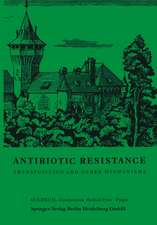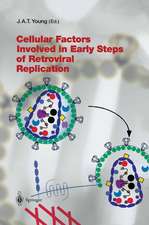Host-Parasite Cellular and Molecular Interactions in Protozoal Infections: Nato ASI Subseries H:, cartea 11
Editat de K. -P. Chang, David Snaryen Limba Engleză Paperback – 12 feb 2012
Din seria Nato ASI Subseries H:
- 18%
 Preț: 953.82 lei
Preț: 953.82 lei -
 Preț: 393.13 lei
Preț: 393.13 lei - 15%
 Preț: 643.34 lei
Preț: 643.34 lei - 15%
 Preț: 643.34 lei
Preț: 643.34 lei - 15%
 Preț: 641.03 lei
Preț: 641.03 lei - 15%
 Preț: 642.83 lei
Preț: 642.83 lei - 15%
 Preț: 642.51 lei
Preț: 642.51 lei - 5%
 Preț: 712.81 lei
Preț: 712.81 lei -
 Preț: 392.97 lei
Preț: 392.97 lei - 15%
 Preț: 640.24 lei
Preț: 640.24 lei - 18%
 Preț: 948.61 lei
Preț: 948.61 lei - 15%
 Preț: 655.92 lei
Preț: 655.92 lei - 15%
 Preț: 655.92 lei
Preț: 655.92 lei - 15%
 Preț: 653.14 lei
Preț: 653.14 lei - 15%
 Preț: 650.19 lei
Preț: 650.19 lei - 15%
 Preț: 655.13 lei
Preț: 655.13 lei - 15%
 Preț: 652.17 lei
Preț: 652.17 lei - 15%
 Preț: 675.58 lei
Preț: 675.58 lei - 18%
 Preț: 958.07 lei
Preț: 958.07 lei - 18%
 Preț: 961.41 lei
Preț: 961.41 lei - 18%
 Preț: 970.56 lei
Preț: 970.56 lei - 5%
 Preț: 1100.30 lei
Preț: 1100.30 lei - 5%
 Preț: 376.43 lei
Preț: 376.43 lei - 15%
 Preț: 650.86 lei
Preț: 650.86 lei - 15%
 Preț: 644.63 lei
Preț: 644.63 lei - 15%
 Preț: 655.60 lei
Preț: 655.60 lei - 18%
 Preț: 963.47 lei
Preț: 963.47 lei - 15%
 Preț: 648.42 lei
Preț: 648.42 lei - 5%
 Preț: 731.43 lei
Preț: 731.43 lei - 15%
 Preț: 653.14 lei
Preț: 653.14 lei - 18%
 Preț: 960.13 lei
Preț: 960.13 lei - 18%
 Preț: 968.34 lei
Preț: 968.34 lei - 18%
 Preț: 953.97 lei
Preț: 953.97 lei - 15%
 Preț: 654.95 lei
Preț: 654.95 lei - 15%
 Preț: 652.49 lei
Preț: 652.49 lei - 15%
 Preț: 650.86 lei
Preț: 650.86 lei - 5%
 Preț: 367.64 lei
Preț: 367.64 lei - 5%
 Preț: 1104.68 lei
Preț: 1104.68 lei - 18%
 Preț: 953.20 lei
Preț: 953.20 lei - 15%
 Preț: 651.99 lei
Preț: 651.99 lei - 15%
 Preț: 647.27 lei
Preț: 647.27 lei - 15%
 Preț: 653.00 lei
Preț: 653.00 lei - 15%
 Preț: 656.25 lei
Preț: 656.25 lei - 18%
 Preț: 962.35 lei
Preț: 962.35 lei - 15%
 Preț: 644.82 lei
Preț: 644.82 lei - 15%
 Preț: 666.55 lei
Preț: 666.55 lei - 15%
 Preț: 642.68 lei
Preț: 642.68 lei - 15%
 Preț: 645.96 lei
Preț: 645.96 lei - 15%
 Preț: 651.84 lei
Preț: 651.84 lei
Preț: 651.02 lei
Preț vechi: 765.90 lei
-15% Nou
Puncte Express: 977
Preț estimativ în valută:
124.57€ • 130.06$ • 103.10£
124.57€ • 130.06$ • 103.10£
Carte tipărită la comandă
Livrare economică 04-18 aprilie
Preluare comenzi: 021 569.72.76
Specificații
ISBN-13: 9783642728426
ISBN-10: 3642728421
Pagini: 452
Ilustrații: XIX, 425 p.
Dimensiuni: 170 x 244 x 24 mm
Greutate: 0.71 kg
Ediția:Softcover reprint of the original 1st ed. 1987
Editura: Springer Berlin, Heidelberg
Colecția Springer
Seria Nato ASI Subseries H:
Locul publicării:Berlin, Heidelberg, Germany
ISBN-10: 3642728421
Pagini: 452
Ilustrații: XIX, 425 p.
Dimensiuni: 170 x 244 x 24 mm
Greutate: 0.71 kg
Ediția:Softcover reprint of the original 1st ed. 1987
Editura: Springer Berlin, Heidelberg
Colecția Springer
Seria Nato ASI Subseries H:
Locul publicării:Berlin, Heidelberg, Germany
Public țintă
ResearchCuprins
Trypanosoma.- Pattern of variant surface glycoprotein coating in nascent metacyclic Trypanosoma brucei in the salivary glands of Glossina morsitans.- Evolution of antigenic variation in African trypanosomes.- Structural studies on the glycophospholipid membrane anchor of Trypanosoma brucei variant surface glycoprotein.- Metabolism of trypanothione and glutathionylspermidine in trypanosomatids.- Differentiation of Trypanosoma brucei from bloodstream to procyclic trypomastigotes.- Digestive enzymes, receptor-mediated endocytosis and their role in the nutrition of the bloodstream-form trypanosome.- The Cytoskeleton of Trypanosoma brucei: Genes and proteins.- Genetic re-assortment of African trypanosomes in Glossina.- Cell surface glycoproteins of Trypanosoma cruzii.- A specific inhibitor of Trypanosoma cruzii neuraminidase found in human plasma.- Definition of Trypanosoma cruzii antigens by antibodies and T cells.- Leishmania.- Molecular pathogenicity of Leishmania in intracellular Parasitism of macrophages: Association of virulent phenotype with increased expression of a major membrane glycoprotein and microsomal N-acetylglucosaminyltransferase.- Infectivity of Leishmania promastigotes is dependent on the expression of a 65,000 dalton surface antigen.- Characterization of developmentally regulated molecules of Leishmania.- Leishmania antigens probed by monoclonal antibodies to Leishmania membrane and to acetylcholine receptor.- Structural studies on surface glycoproteins of Leishmania promastigotes: Isolation, amino acid composition and amino terminal sequence studies.- Membrane attachment of the major surface protein of Leishmania promastigotes.- The promastigote surface protease of Leishmania.- Acid Protease activity of Leishmania gp63 and its possible role in virulence.- The roles of surface membrane enzymes and transporters in the survival of Leishmania.- The plasma membrane H+-ATPase of Leishmania donovani promastigotes.- Phosphomonoesterases and proteinases of Leishmanias.- The structure, localization, and function of the lipophosphoglycan of Leishmania donovani.- Leishmania host-parasite interactions: The development of chemotherapeutic targets and specific drug delivery systems I. Lipoprotein-mediated antileishmanial chemotherapy.- Recognition processes involved in binding and ingestion of Leishmania donovani by host macrophages.- Interaction of Leishmania and membrane-stabilizing drugs with human phagocytic cells.- Suppression of macrophage accessory functions by Leishmania donovani.- Plasmodium & Babesia.- Extracellular development of erythrocytic malaria parasites.- The relative roles of N- and O-linked carbohydrate in the invasion of human red cells by merozoites of Plasmodium falciparum.- Antigens of Plasmodium falciparum merozoites: Identification, isolation and functional characterization.- Studies on the Plasmodium falciparum 195,000 molecular mass merozoite surface antigen precursor.- Aspects of posttranslational modification of a major Plasmodium falciparum merozoite surface antigen.- Export of Plasmodium falciparum proteins to the host erythrocyte membrane: Special problems of protein trafficking and topogenesis.- Inhibition of knob formation on Plamodium falciparum-infected erythrocytes by 2-fluoro-L-histidine.- The knob protein gene of Plasmodium falciparum.- Phosphoproteins associated with the host erythrocyte membrane during Plasmodium chabaudi infection.- Malarial sporozoite — hepatocyte interactions mediating invasion and exoerythrocytic development.- Immuno-electron microscopic observations on Plasmodiumfalciparum sporozoites using ultracryomicrotomy.- Structural homology of membrane proteins of Babesia rodhaini.- Toxoplasma & Entamoeba.- The mechanism by which interferon gamma blocks the growth of Toxoplasma gondii in cultured fibroblasts.- Modification of host cell phagocytic compartments by intracellular Toxoplasma gondii.- Characterization of a 42 kilodalton rhoptry antigen of Toxoplasma gondii.- Entamoeba histolytica: Activation and release of membrane dense bodies.- Entamoeba histolytica: Effect of bacterial associates on isoenzyme patterns and virulence.- Insect vector.- Trypanosomatid-vector interfaces — In vitro studies on parasite substrate interactions.- The microecology of Leishmania in the gut and proboscis of the sandfly.- The cellular and molecular interactions of malaria species with their mosquito vectors.- Concluding Remarks.
















